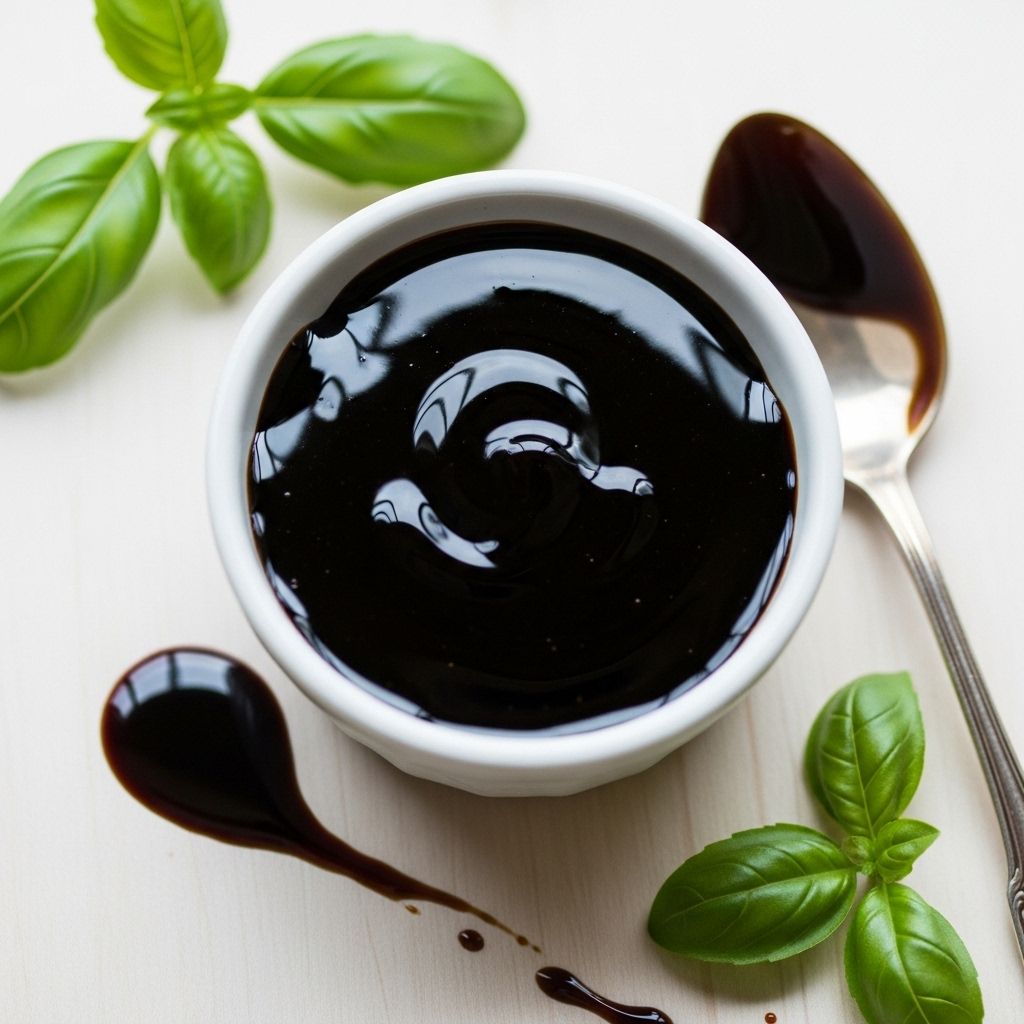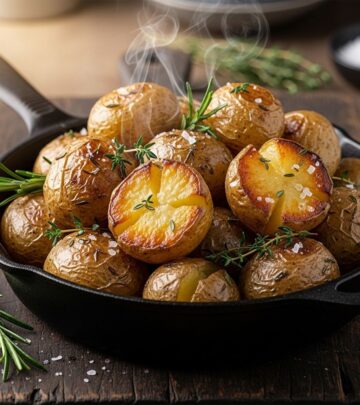Balsamic Glaze Recipe: Simple 2-Ingredient, 20-Minute Reduction
Transform ordinary meals into gourmet experiences with this versatile, two-ingredient wonder

Image: HearthJunction Design Team
Homemade Balsamic Glaze: Simple Elegance for Every Kitchen
There’s something magical about a good balsamic glaze. This simple reduction transforms ordinary ingredients into extraordinary culinary experiences with its perfect balance of sweet and tangy flavors. While store-bought versions are convenient, nothing compares to the satisfaction of creating your own homemade balsamic glaze, customized exactly to your taste preferences. The best part? You only need two basic ingredients and about 20 minutes to create this versatile kitchen essential.
Balsamic glaze (also called balsamic reduction) concentrates all the complex flavors of balsamic vinegar into a syrupy consistency that’s perfect for drizzling over countless dishes. Unlike many gourmet-sounding recipes, this one is genuinely simple yet delivers results that will make you feel like a professional chef. Let’s explore how to make this culinary secret weapon and the many ways it can elevate your cooking.
What Is Balsamic Glaze?
Balsamic glaze is essentially balsamic vinegar that has been simmered down to create a thicker, more intensely flavored condiment. During the reduction process, the water content evaporates, concentrating the vinegar’s natural sweetness and complex flavor profile. Adding a small amount of sugar enhances this sweetness and helps achieve that perfect syrupy consistency.
While you can purchase pre-made balsamic glaze, making your own allows you to control the sweetness, thickness, and additional flavoring elements. Homemade also means no preservatives or artificial ingredients—just pure, intense flavor in its most natural form.
Ingredients for Perfect Balsamic Glaze
The beauty of balsamic glaze lies in its simplicity. At its most basic, you need just two ingredients:
- Balsamic Vinegar – 1 cup
- Brown Sugar – 2 tablespoons
While traditional recipes from Italy might use only balsamic vinegar reduced over a long period, adding a small amount of brown sugar speeds up the process and ensures a consistent result. The molasses in brown sugar complements the vinegar’s existing flavor profile perfectly.
For the balsamic vinegar, you don’t need to use the expensive, aged varieties (though you certainly can). A decent quality, mid-range balsamic vinegar works perfectly for reduction, as the cooking process will concentrate its flavors anyway.
Step-by-Step Instructions
Gathering Your Equipment
Before you begin, make sure you have:
- A small to medium saucepan (non-reactive is best)
- A wooden spoon or silicone spatula for stirring
- Measuring cups and spoons
- A glass jar with a tight-fitting lid for storage
The Reduction Process
- Combine Ingredients: Add the balsamic vinegar and brown sugar to your saucepan.
- Heat and Dissolve: Place the pan over medium heat and stir constantly until the sugar has completely dissolved into the vinegar.
- Bring to a Boil: Allow the mixture to come to a gentle boil, still over medium heat.
- Reduce Heat and Simmer: Once boiling, reduce the heat to low and allow the mixture to simmer. This is where patience becomes important.
- Monitor the Reduction: Simmer the mixture until it’s reduced by approximately half and has thickened enough to coat the back of a spoon, typically about 15-20 minutes.
- Cool Completely: Remove from heat and allow the glaze to cool. It will continue to thicken as it cools.
- Store Properly: Transfer your cooled balsamic glaze to a glass jar or bottle with a tight-fitting lid.
How to Know When It’s Ready
Determining when your balsamic glaze has reached the perfect consistency can be tricky, especially for beginners. Here’s the most reliable test: dip the back of a spoon into the glaze, then run your finger through it. If the line you create remains distinct and the glaze doesn’t immediately run back together, it’s ready.
Remember that the glaze will continue to thicken as it cools, so it’s better to err on the side of slightly thinner while it’s still hot. If you reduce it too much and it becomes too thick when cooled, you can always reheat it with a small amount of water to thin it back to your desired consistency.
Storage and Shelf Life
Properly stored in an airtight container in the refrigerator, homemade balsamic glaze will maintain its quality for about 2-3 weeks. The high sugar content and acidity act as natural preservatives, but without the commercial additives of store-bought versions, it won’t last indefinitely.
For longer storage, you can freeze balsamic glaze in small portions, such as in an ice cube tray. Once frozen, transfer the cubes to a freezer bag. This method allows you to defrost only what you need for individual meals.
Creative Variations
While the classic two-ingredient recipe produces excellent results, you can personalize your balsamic glaze with additional ingredients to suit different culinary applications:
Savory Variations
- Garlic Infused: Add 2-3 crushed garlic cloves during reduction and remove before storing.
- Herb Enhanced: Add a sprig of rosemary, thyme, or a bay leaf while reducing.
- Spicy Kick: Include a pinch of red pepper flakes or a small amount of freshly ground black pepper.
Sweet Variations
- Honey Balsamic: Substitute the brown sugar with an equal amount of honey for a different sweetness profile.
- Fruit Infused: Add orange zest, strawberry puree, or fig preserves for fruit-forward versions.
- Maple Twist: Use maple syrup instead of brown sugar for a different dimension of sweetness.
Culinary Applications
The versatility of balsamic glaze is truly remarkable. Here are some inspired ways to incorporate it into your cooking:
Salads and Vegetables
Balsamic glaze transforms ordinary salads into restaurant-quality dishes. Try it drizzled over:
- Mixed greens with toasted nuts and dried cranberries
- Fresh strawberry and spinach salad
- Grilled or roasted vegetables, especially beets, carrots, and Brussels sprouts
- Caprese salad (fresh mozzarella, tomatoes, and basil)
Protein Pairings
Balsamic glaze adds sophisticated flavor to various proteins:
- Grilled or pan-seared salmon
- Roasted pork tenderloin
- Chicken breasts or thighs
- Lamb chops
Cheese and Appetizers
Create impressive appetizers with minimal effort:
- Drizzle over Gorgonzola or aged cheeses
- Finish bruschetta with a light touch of glaze
- Enhance grilled portobello mushrooms
- Add to a charcuterie board for dipping
Pasta and Grains
Add depth to simple grain dishes:
- Finish pasta primavera with a light drizzle
- Add to risotto just before serving
- Enhance grain bowls with a teaspoon of glaze
Desserts
Perhaps surprisingly, balsamic glaze pairs beautifully with sweets:
- Drizzle over vanilla ice cream
- Finish fresh berries with a light touch
- Add to chocolate desserts for complexity
Troubleshooting Common Issues
Even with such a simple recipe, occasional challenges may arise. Here are solutions to common problems:
Glaze Too Thin
If your glaze isn’t thickening properly, it simply needs more reduction time. Continue simmering on low heat, being careful not to burn it. Remember that it will thicken further upon cooling.
Glaze Too Thick
If your glaze becomes too thick after cooling, simply reheat it gently with a small amount of water (start with just a teaspoon) until you reach your desired consistency.
Burnt Flavor
Balsamic reduction can burn if the heat is too high. If you notice a burnt smell or taste, unfortunately, it’s best to start over. Always reduce over low heat and watch carefully, especially as it thickens.
Crystallization
If sugar crystals form in your glaze during storage, gently reheat it to dissolve them.
Cook’s Notes and Expert Tips
Based on experience making balsamic glaze countless times, here are some professional tips to ensure perfect results:
- Use a wider, shallow pan for faster reduction without burning.
- The glaze will appear thinner when hot—always judge final consistency after cooling.
- Avoid metal containers for storage as the acidity can react with them.
- A splash of port or red wine can add complexity to your reduction.
- For a smoother glaze, strain through a fine-mesh sieve before storing.
Frequently Asked Questions (FAQs)
Q: Can I make balsamic glaze without sugar?
A: Yes, traditional balsamic glaze is made with just balsamic vinegar reduced for a longer period. However, adding sugar helps achieve the right consistency faster and balances the acidity. For sugar-free versions, consider using a small amount of natural sweeteners like maple syrup or honey.
Q: How can I tell if my balsamic glaze has gone bad?
A: While balsamic glaze has a relatively long shelf life, signs of spoilage include mold, off smells, or bubbling/fermentation. When in doubt, it’s safest to make a fresh batch.
Q: Can I use white balsamic vinegar to make glaze?
A: Absolutely! White balsamic reduction follows the same process and creates a beautiful golden-colored glaze that works well with lighter dishes where the dark color of traditional balsamic might be visually overwhelming.
Q: Is balsamic glaze the same as balsamic vinegar?
A: No, balsamic glaze is a reduction of balsamic vinegar, typically with added sweeteners. It’s thicker, sweeter, and more concentrated in flavor than plain balsamic vinegar.
Q: How can I prevent my kitchen from smelling strongly of vinegar?
A: Run your kitchen exhaust fan while making the reduction, and keep windows open if possible. A small pot of simmering water with cinnamon or citrus peels can help neutralize lingering vinegar odors afterward.
Creating your own balsamic glaze is one of those simple culinary techniques that offers tremendous returns in flavor enhancement for minimal effort. With just two ingredients and about 20 minutes of your time, you’ll have a versatile condiment that transforms ordinary meals into memorable dining experiences. Whether drizzled over fresh summer vegetables, used to finish a perfectly grilled protein, or even added to desserts, homemade balsamic glaze demonstrates that sometimes the simplest additions make the most profound difference in cooking.
References
- https://www.allrecipes.com/recipe/228418/balsamic-glaze/
- https://www.allrecipes.com/article/how-to-make-balsamic-glaze/
- https://www.allrecipes.com/recipe/242091/easy-balsamic-glaze/
- https://www.allrecipes.com/recipe/241745/perfect-honey-balsamic-glaze/
- https://www.allrecipes.com/recipe/276156/balsamic-glazed-chicken/
Read full bio of medha deb












